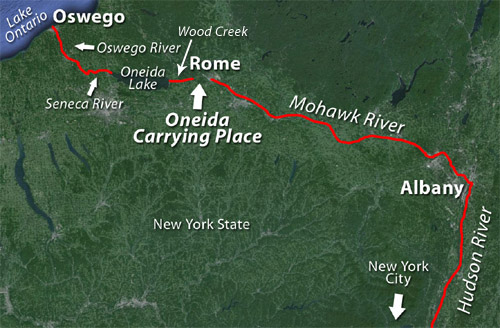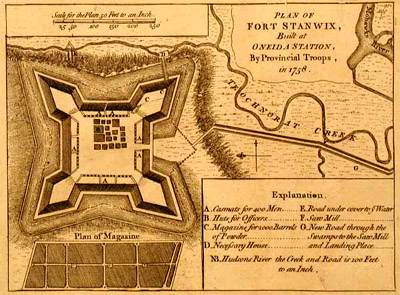 |
Fort Stanwix
Rome, New York, USA
|
|
 |
Constructed: 1758 - 1762
Used by: Great Britain, USA
Conflict in which it participated:
French and Indian War,
American Revolutionary War
Also known as: Fort Schuyler
|
The Oneida Carrying Place was an ancient trail that joined the Atlantic Ocean with Lake Ontario. Fort Stanwix was built by the British from 1758 to 1762 to protect (control) that well-used portage through Oneida Indian territory. The fort was named for British general John Stanwix (1690-1765), who ordered and oversaw its construction.
|
 |
|
|
By 1768 Fort Stanwix, already inactive and somewhat dilapidated, was the location of a treaty negotiation between the British and the Iroquois. A solid boundary line between the Indian lands and colonial settlements was desired by both sides: By the Indians in hopes of holding back the inexorable tide of white people, and by the British in hopes of quelling frontier violence. The Iroquois wound up ceding what is now Kentucky to the settlers, though without bothering to consult the tribes that primarily lived in that area, the Shawnee, Delaware, and Cherokee...which pretty much ensured more violence in that region. After the completion of the treaty negotiations, Fort Stanwix was abandoned and left to ruin.
|

How folks traveled and/or shipped goods from the Atlantic to the Great Lakes until the Erie Canal was completed in 1825: Up the Hudson River from New York; Left at the Mohawk River at Albany; Carry your stuff o'er the Oneida Carrying Place from what is now Rome to Wood Creek; Paddle your way west through the Oneida Lake to the Seneca River; Take a right up the Oswego River; Sail, exhausted, into Lake Ontario. Then recruit more hands, because all of your men have died on the arduous journey!
|
 |
The fort was reoccupied by American troops on June 12, 1776 and renamed Fort Schulyer for Philip J. Schuyler (1733-1804), a general in the Continental Army...though it was generally still known as Fort Stanwix, because let's face it, Stanwix is a way cooler name.
On August 3, 1777 the fort was besieged by British, German, Loyalist American, Canadian and Indian troops and warriors. A Patriot relief column of some 800 men headed in that direction to raise the siege, and on August 6 were ambushed six miles east of Fort Stanwix by a Loyalist and Indian force at least 450 strong, sent from the siege to stop the column.
|
|
|
In the resulting Battle of Oriskany, the Patriots lost more than half their number and were scattered. While the Loyalists were tending to this matter, however, the troops at Fort Stanwix attacked their besiegers, looting and destroying enemy stores.
Demoralized, reduced in number and having heard of another Patriot relief column led by Benedict Arnold (1740-1801) in his pre-traitorous state on the way, the British-led forces withdrew. The British failure to capture Fort Stanwix, leading to their defeat in the Battles of Saratoga (September 19 and October 7, 1777), was a turning point of the American Revolutionary War (1775-1783).
|
Fort Stanwix burned to the ground on May 13, 1781 and was not rebuilt. Despite its lack of existence, what was left of the fort was used as the location of another treaty negotiation betwixt the Americans and Indians in 1784. Somehow ignored in the Treaty of Paris (1783) that ended the American Revolutionary War, the Iroqois Nation was still technically at war with the US government. The Treaty of Fort Stanwix started out with the intention of declaring peace, but somehow also ended up with the Iroquois ceding Ohio and a number of other lands, again without consulting the tribes living in those areas.
|
 |
Fort Stanwix in its daunting, spiny 1777 appearance. Click on it, it's huge. |
|
A blockhouse was built on what was once the fort's parade grounds during the War of 1812 (1812-1815), but what was left of Fort Stanwix was completely dismantled starting in 1828. The last vestiges of the fort were built over by the expanding city of Rome by 1830.
|
|

Fort Stanwix in its French & Indian War days.
|
 |
Interest in Fort Stanwix was rekindled by the Sesquicentennial celebrations of the campaigns of 1777, which took place, perhaps predictably, in 1927. President Franklin Delano Roosevelt (1882-1945) signed the Fort Stanwix Act in 1935, which established Fort Stanwix National Monument, but donations to reconstruct the fort didn't reach critical mass until the early 1970's.
Fort Stanwix was rebuilt from 1973 to 1976, and the fort opened to the public in the heroically (and somewhat exhaustingly, in my experience) bicentennial year of 1976.
|
|
|
I was contacted in January of 2014 by John Carmody, secretary of the Fort Bull Research Group in Rome, New York. John was kind enough to say nice things about Starforts.com, and said that his group is dedicated to researching the history of the six French and Indian War Forts built between 1755 and 1758 in what is now Rome. Six forts!! John's group has also been maintaining the remains of one of those forts, Fort Wood Creek, which was constructed by the British to replace Fort Bull, which was destroyed by the dastardly French on March 27, 1756.
The forts built to protect the Oneida Carry were:
Fort Williams (1755)
Fort Bull (1755)
Fort Newport (1756)
Fort Wood Creek also known as Fort Eagle (1756)
Fort Craven (1756)
Fort Stanwix (1758)
In 1759, a seventh, small fort was built just west of Fort Wood Creek, which was adorably named Fort Ricky. Assumedly Fort Ricky was so cute and little that nobody took it seriously enough to count it amongst the Oneida Carry's main defenders. The Fort Bull Research Group is ready and willing to educate and share information about the Oneida Carry during the French and Indian War: Anyone who is interested should contact John Carmody directly at fenianagain@hotmail.com. Muchas gracias to John for the info about all of Rome's forts! I'm insanely jealous, in that the town where I live has exactly 0% as many starforts as does his.
|
|
|
|
|
|
|
 |




